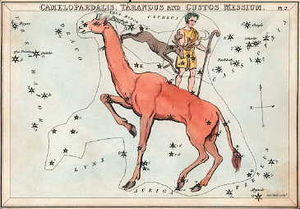Camelopardalis
| Constellation | |
List of stars in Camelopardalis |
|
| Abbreviation | Cam |
|---|---|
| Genitive | Camelopardalis |
| Pronunciation | /kəˌmɛləˈpɑrdəlɨs/ Camélopárdalis, genitive the same |
| Symbolism | the Giraffe |
| Right ascension | 6 h |
| Declination | +70° |
| Quadrant | NQ2 |
| Area | 757 sq. deg. (18th) |
| Main stars | 2, 8 |
| Bayer/Flamsteed stars |
36 |
| Stars with planets | 3 |
| Stars brighter than 3.00m | 0 |
| Stars within 10.00 pc (32.62 ly) | 3 |
| Brightest star | β Cam (4.03m) |
| Nearest star | LHS 2459 (17.58 ly, 5.39 pc) |
| Messier objects | 0 |
| Meteor showers | October Camelopardalids |
| Bordering constellations |
Draco Ursa Minor Cepheus Cassiopeia Perseus Auriga Lynx Ursa Major |
| Visible at latitudes between +90° and −10°. Best visible at 21:00 (9 p.m.) during the month of February. |
|
Camelopardalis is a large but faint constellation in the northern sky. The constellation was first described by Jakob Bartsch in 1624, but was created earlier by Petrus Plancius. In older astronomy books, one will sometimes see an alternative spelling of the name as Camelopardus.
Contents |
Etymology
Coined in English 1785, the word camelopardalis comes from the Latin[1] and it is the romanisation of the Greek "καμηλοπάρδαλις" meaning "giraffe",[2] from "κάμηλος" (kamēlos), "camel"[3] + "πάρδαλις" (pardalis), "leopard",[4] due to its having a long neck like a camel and spots like a leopard.
Notable features
Stars
Although Camelopardalis is the 18th largest constellation, it is not a particularly bright constellation, as the brightest stars are only of fourth magnitude. β Camelopardalis is the brightest star, at apparent magnitude 4.03. This star is a double star, with components of magnitudes 4.0 and 7.4. The second brightest is CS Camelopardalis, which has neither a Bayer nor a Flamsteed designation. It is of magnitude 4.21 and is slightly variable. Other double stars interesting to amateurs are OΣ 67 Camelopardalis with a greenish companion, 19 Camelopardalis (probably an optical double), and Σ 1694 Camelopardalis (a blue and yellow optical double).[5] Other variable stars are U Camelopardalis, VZ Camelopardalis, and Mira variables T Camelopardalis, X Camelopardalis, and R Camelopardalis.[5]
Deep sky objects
NGC 2403 is a spiral galaxy approximately 11 million light years distant. It is of magnitude 8.4. NGC 1502 is a magnitude 6.0 open cluster about 6,800 light years distant. NGC1501 is a planetary nebula. NGC 2655 is a small galaxy. IC 342 is one of the brightest two galaxies in the IC 342/Maffei Group of galaxies
History

The faintness of the constellation, and that of the nearby constellation Lynx, led to the early Greeks considering this area of the sky to be empty. Camelopardalis was not defined as a constellation until the seventeenth century and thus has no mythology associated with its stars.
Visualizations
H. A. Rey has suggested an alternative way to connect the stars of Camelopardalis into a giraffe figure.
The giraffe's body consists of the quadrangle of stars α Cam, β Cam, BE Cam, and γ Cam: α Cam and β Cam being of the fourth magnitude. The stars HD 42818 (HR 2209) and M Cam form the head of the giraffe, and the stars M Cam and α Cam form the giraffe's long neck. Stars β Cam and 7 Cam form the giraffe's front leg, and variable stars BE Cam and CS Cam form the giraffe's hind leg.
Notes
- ↑ camelopardalis, Charlton T. Lewis, Charles Short, A Latin Dictionary
- ↑ καμηλοπάρδαλις, Henry George Liddell, Robert Scott, A Greek-English Lexicon, on Perseus Digital Library
- ↑ κάμηλος, Henry George Liddell, Robert Scott, A Greek-English Lexicon, on Perseus Digital Library
- ↑ πάρδαλις, Henry George Liddell, Robert Scott, A Greek-English Lexicon, on Perseus Digital Library
- ↑ 5.0 5.1 Norton, Arthur P. (1973). Norton's Star Atlas. pp. 118–119. ISBN 0-85248-900-5.
References
- H. A. Rey, The Stars — A New Way To See Them. Enlarged World-Wide Edition. Houghton Mifflin, Boston, 1997. ISBN 0-395-24830-2.
- Ian Ridpath and Wil Tirion (2007). Stars and Planets Guide, Collins, London. ISBN 978-0007251209. Princeton University Press, Princeton. ISBN 978-0691135564.
- NASA - Voyager Interstellar Mission Characteristics
External links
|
||||||||||||||
|
|||||
|
||||||||||||||||||||||||||||||||